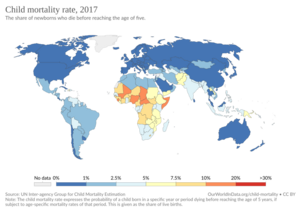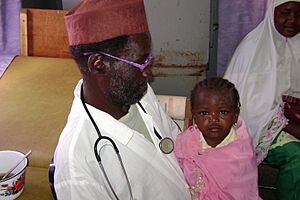Child mortality facts for kids
Child mortality means the death of children before their fifth birthday. The child mortality rate (also called the under-five mortality rate) tells us how many children out of every 1,000 live births die before they turn five years old.
This number includes babies who die very early, like during the first 28 days of life (neonatal mortality), and those who die within their first year (infant mortality).
Reducing child deaths is a big goal for the United Nations. One of their Sustainable Development Goals aims to stop preventable deaths of newborns and children under five by 2030. The goal is for all countries to have fewer than 25 deaths per 1,000 live births for children under five.
Child mortality rates have dropped a lot in the last 40 years. In 1990, about 12.6 million children under five died. By 2020, this number fell to 5 million. That's a huge improvement! However, about 15,000 children under five still die every day from causes that could often be prevented. Most of these deaths happen in places like sub-Saharan Africa and South Asia. Just six countries account for half of all these deaths: China, India, Pakistan, Nigeria, Ethiopia, and the Democratic Republic of the Congo. Nearly half of these children die within their first month of life.
Contents
Understanding Child Mortality Rates
Child mortality refers to the number of children who die before their fifth birthday, out of every 1,000 live births. There are more specific terms to describe deaths at different young ages:
- Perinatal mortality rate: This is the number of deaths within the first week after birth, compared to the total number of births.
- Neonatal mortality rate: This counts deaths within the first 28 days of life, compared to the total number of births.
- Infant mortality rate: This measures deaths within the first 12 months of life (before their first birthday), compared to the total number of births.
- Under-5 mortality rate: This is the total number of deaths before a child's fifth birthday, compared to the total number of births.
Deaths that happen around birth (perinatal) are often due to being born too early or having birth defects. Deaths in the first month (neonatal) can be linked to the care a hospital provides, birth defects, or problems during birth. Infant deaths (before age one) can be caused by early birth, low birth weight, poor nutrition, or infections.
Main Causes of Child Deaths
Many things can cause children under five to die. The most common reasons include:
- Problems from being born too early (preterm birth).
- Lung infections like Pneumonia.
- Issues that happen during childbirth.
- Serious infections in newborns (neonatal sepsis).
- Severe Diarrhea.
- Diseases like Malaria.
- Poor nutrition (malnutrition).
Child mortality rates are different around the world. Countries that are still developing often have higher rates than richer countries. For example, in Chad, about 96 children out of every 1,000 live births die as infants. In Japan, that number is only about 2.2 per 1,000.
In 2010, about 7.6 million children died globally, mostly in less developed countries. Many of these deaths were from infections and disorders. Besides infections, other causes include being born too early, birth defects, and complications during birth. In poorer countries, poor nutrition is a major reason for child deaths. Pneumonia, diarrhea, and malaria together cause one out of every three deaths before age five. Also, nearly half of all deaths in children under five are linked to poor nutrition.
Preventing Child Deaths
Child survival is a big part of public health. It focuses on reducing the number of children who die. Programs for child survival aim to tackle the most common causes of death, such as diarrhea, pneumonia, malaria, and problems newborns face. Sadly, about 5.6 million children under five die each year, mostly from causes that could be prevented.
The strategies to help children survive are part of the Sustainable Development Goals (SDGs). These goals aim to end preventable child deaths by 2030. To reach these goals, many countries, especially in sub-Saharan Africa and South Asia, need to make faster progress. If progress isn't sped up, about 60 million children under five could die between 2017 and 2030.
Simple Ways to Save Lives
About two-thirds of child deaths can be prevented. Many children could be saved with simple, affordable methods. These include:
- Vaccines: These shots protect children from serious diseases.
- Antibiotics: Medicines to treat infections.
- Micronutrient supplements: Giving children important vitamins and minerals.
- Insecticide-treated bed nets: These nets protect children from mosquito bites that cause malaria.
- Better family care: Including good hygiene and feeding practices.
- Breastfeeding: This provides babies with important nutrients and protection.
- Oral rehydration therapy (ORT): A simple drink to treat dehydration from diarrhea.
Simple actions like handwashing with soap can greatly reduce deaths from breathing problems and diarrhea, cutting them by almost 50 percent.
Even though vaccines have helped reduce diseases like polio and measles, about 30 million children still don't get these important shots. Measles and tetanus still kill over 1 million children under five each year.
Giving children Vitamin A supplements costs very little (about $0.02 per capsule) and can prevent blindness and death. While it can reduce overall deaths by 12 to 24 percent, only 70 percent of children who need it received it in 2015.
Oral rehydration therapy (ORT) is a very effective way to treat fluid loss from diarrhea. However, only about 4 out of 10 children with diarrhea receive this treatment.
Basic care for newborns can save many lives. This includes making sure mothers are vaccinated against tetanus, having clean birth practices, drying and wrapping the baby right after birth, keeping the baby warm, and encouraging immediate and continued breastfeeding. Vaccinations and treating infections with antibiotics are also key.
Having Improved sanitation and access to clean drinking water can also reduce childhood infections and diarrhea. As of 2017, many people around the world still don't have access to basic sanitation or safe drinking water.
Global Efforts to Help
Organizations like UNICEF and other non-governmental groups work hard to promote child survival worldwide. Major donors include the World Bank and government agencies from countries like the UK, Canada, and the United States.
There has been great progress in reducing child deaths since 1990. The total number of deaths for children under five dropped from 12.6 million in 1990 to about 5.5 million in 2020. This means the global under-5 mortality rate fell by 59%, from 93 deaths per 1,000 live births in 1990 to 36 in 2020.
The Sustainable Development Goals have set new targets: to reduce newborn mortality to 12 per 1,000 live births and under-5 mortality to 25 per 1,000 live births in every country. In 2019, 122 countries had already met these goals. The World Health Organization (WHO) supports fair health care for everyone, so all countries can have proper health services without financial barriers.
Where Child Deaths Happen Most
Child mortality rates have been falling as countries develop. From 2000 to 2010, child deaths dropped from 9.6 million to 7.6 million. To reduce these rates further, there needs to be better education, higher standards of healthcare, and more careful childbearing practices. Having trained professionals at birth, encouraging breastfeeding, and providing access to clean water, sanitation, and immunizations can all help. In 2016, the world average was 41 deaths per 1,000 live births, down from 93 in 1990. This means 5.6 million children under five died in 2016.
Differences Around the World
There are huge differences in under-5 mortality rates. In the country with the highest rate, a child is about 60 times more likely to die before age five than in the country with the lowest rate. Sub-Saharan Africa still has the highest rates in the world. All six countries with rates above 100 deaths per 1,000 live births are in this region, with Somalia having the highest.
About 80% of all under-5 deaths happen in just two regions: sub-Saharan Africa and South Asia. Six countries account for half of these global deaths: India, Nigeria, Pakistan, the Democratic Republic of the Congo, Ethiopia, and China. India and Nigeria alone make up almost a third of all under-five deaths worldwide.
There are also big differences between rich and poor families within developing countries. For example, in India, children from the poorest families are three times more likely to die before their fifth birthday than children from the richest families. A study found that in most low- and middle-income countries (not including China), children from the poorest homes are twice as likely to die before age five compared to those from the richest homes.
Researchers have also mapped child deaths in great detail, down to small local areas. This helps in understanding where help is needed most to reduce child mortality.
The survival rate of children in a country is linked to things like how many children women have and how wealth is shared. When more children survive, the average income in a country can increase, and families may choose to have fewer children.
COVID-19 and Child Deaths
Interestingly, child mortality actually dropped in 2020 when the COVID-19 pandemic hit the world. Children were among the groups least affected by deaths from COVID-19. Out of millions of COVID-19 deaths, only a very small percentage (about 0.4%) were in people under 20 years old. Of those, 42% were in children under nine.
See also
- List of countries by infant mortality rate
- Death of a child





